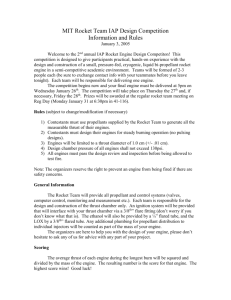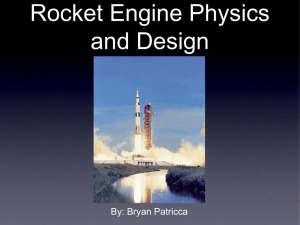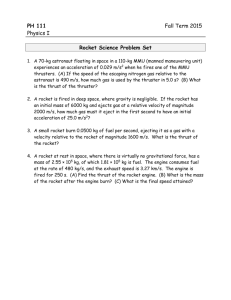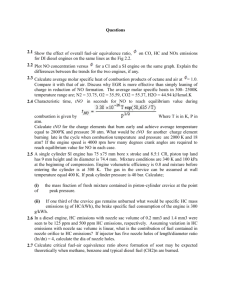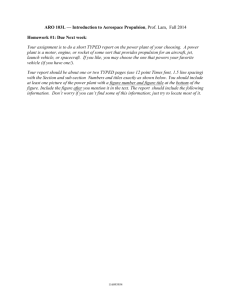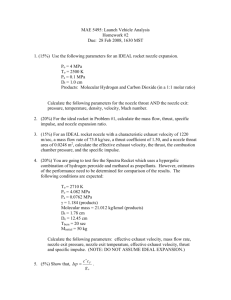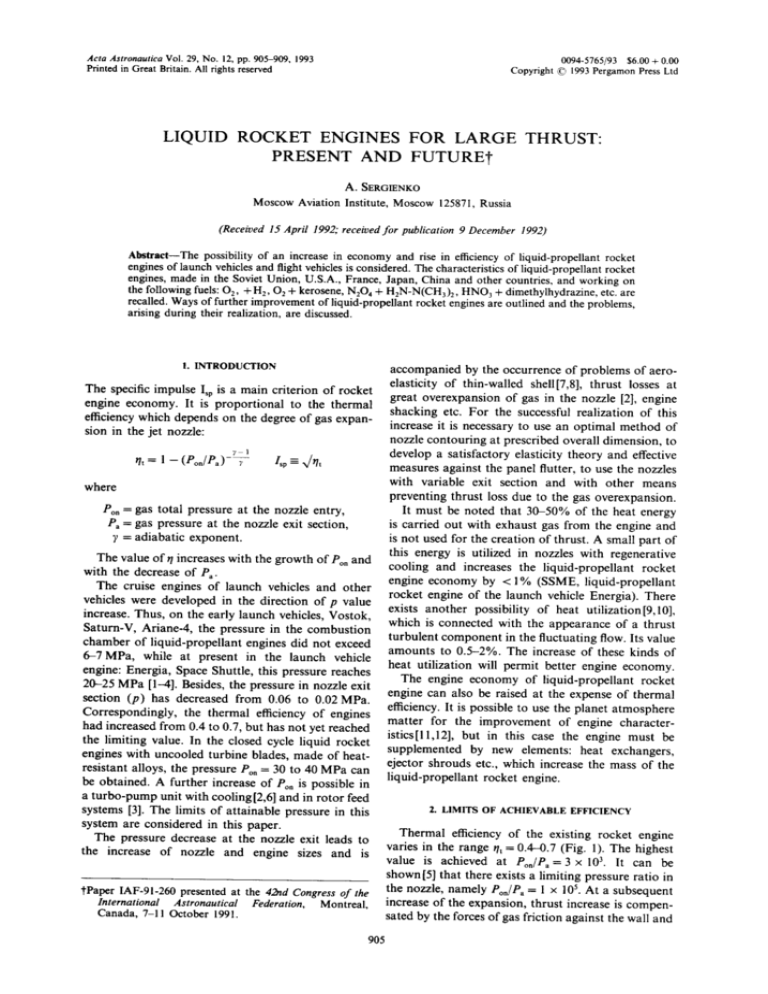
Acta Astronautica Vol. 29, No. 12, pp. 905-909, 1993
Printed in Great Britain. All rights reserved
0094-5765/93 $6.00 + 0.00
Copyright © 1993 Pergamon Press Ltd
LIQUID ROCKET ENGINES FOR LARGE THRUST:
PRESENT AND FUTURE'["
A. SERGIENKO
Moscow Aviation Institute, Moscow 125871, Russia
(Received 15 April 1992; received for publication 9 December 1992)
Abstract--The possibility of an increase in economy and rise in efficiency of liquid-propellant rocket
engines of launch vehiclesand flight vehicles is considered. The characteristics of liquid-propellant rocket
engines, made in the Soviet Union, U.S.A., France, Japan, China and other countries, and working on
the followingfuels: 02, +H2, 02 + kerosene, N204 + H2N-N(CH3)2, HNO 3+ dimethylhydrazine,etc. are
recalled. Ways of further improvement of liquid-propellant rocket engines are outlined and the problems,
arising during their realization, are discussed.
!. INTRODUCTION
accompanied by the occurrence of problems of aeroelasticity of thin-walled shell[7,8], thrust losses at
great overexpansion of gas in the nozzle [2], engine
shacking etc. For the successful realization of this
increase it is necessary to use an optimal method of
nozzle contouring at prescribed overall dimension, to
develop a satisfactory elasticity theory and effective
measures against the panel flutter, to use the nozzles
with variable exit section and with other means
preventing thrust loss due to the gas overexpansion.
It must be noted that 30-50% of the heat energy
is carried out with exhaust gas from the engine and
is not used for the creation of thrust. A small part of
this energy is utilized in nozzles with regenerative
cooling and increases the liquid-propellant rocket
engine economy by < 1% (SSME, liquid-propellant
rocket engine of the launch vehicle Energia). There
exists another possibility of heat utilization[9,10],
which is connected with the appearance of a thrust
turbulent component in the fluctuating flow. Its value
amounts to 0.5-2%. The increase of these kinds of
heat utilization will permit better engine economy.
The engine economy of liquid-propellant rocket
engine can also be raised at the expense of thermal
efficiency. It is possible to use the planet atmosphere
matter for the improvement of engine characteristics[ll,12], but in this case the engine must be
supplemented by new elements: heat exchangers,
ejector shrouds etc., which increase the mass of the
liquid-propellant rocket engine.
The specific impulse Isp is a main criterion of rocket
engine economy. It is proportional to the thermal
efficiency which depends on the degree of gas expansion in the jet nozzle:
7 1
q, = l - ( P on/Pa ) - T
Isp = xfil,
where
Po, = gas total pressure at the nozzle entry,
Pa = gas pressure at the nozzle exit section,
), = adiabatic exponent.
The value of ~/increases with the growth of Pon and
with the decrease of Pa.
The cruise engines of launch vehicles and other
vehicles were developed in the direction of p value
increase. Thus, on the early launch vehicles, Vostok,
Saturn-V, Ariane-4, the pressure in the combustion
chamber of liquid-propellant engines did not exceed
6-7 MPa, while at present in the launch vehicle
engine: Energia, Space Shuttle, this pressure reaches
20-25 MPa [1-4]. Besides, the pressure in nozzle exit
section (p) has decreased from 0.06 to 0.02 MPa.
Correspondingly, the thermal efficiency of engines
had increased from 0.4 to 0.7, but has not yet reached
the limiting value. In the closed cycle liquid rocket
engines with uncooled turbine blades, made of heatresistant alloys, the pressure Pon = 30 to 40 MPa can
be obtained. A further increase of Pon is possible in
a turbo-pump unit with cooling [2,6] and in rotor feed
systems [3]. The limits of attainable pressure in this
system are considered in this paper.
The pressure decrease at the nozzle exit leads to
the increase of nozzle and engine sizes and is
"['Paper IAF-91-260 presented at the 42rid Congress of the
International Astronautical Federation, Montreal,
Canada, 7-11 October 1991.
2. LIMITS OF ACHIEVABLE EFFICIENCY
Thermal efficiency of the existing rocket engine
varies in the range qt = 0.4--0.7 (Fig. 1). The highest
value is achieved at P o . / P . = 3 x 103. It can be
shown[5] that there exists a limiting pressure ratio in
the nozzle, namely Pon/P. = 1 x 105. At a subsequent
increase of the expansion, thrust increase is compensated by the forces of gas friction against the wall and
905
906
A. SERGIENKO
1.0
1000
3900
y=l.2
. . . . . . . .
--
_[
800
0 8
2 600
1]t
~
~
0.6
200
3700
0.4
-
2
3
4
2.0
I
2.5
~TO
Fig. 3. Characteristics of liquid rocket engine with singlestage combustion. 02 + Kerosene, Po./P~= 5952, ct = 0.95.
1, Po,; 2, Is, (P, = PH); 3, Pc; 4, epo; 5, Ppf; 6, /so.
a
by forces of nozzle case inertia. Therefore, in the
liquid rocket engines (with Bryton cycle), the thermal
efficiency cannot exceed 0.75-0.85. To reach this
limit, it is necessary to increase the pressure differential by not less than one order of magnitude as
compared with up-to-date liquid-propellant rocket
engines.
The high values of the pressure P® are ensured by
the fuel component feed system--a turbo-pump unit.
The value of Pon is proportional to the turbine
specific power. It can be increased by increasing gas
temperature at the turbine entry. In the modern
liquid rocket engine, the gas temperature, T~o at the
uncooled turbine entry amounts to 800-1000 K and
at these conditions, the Po~ reaches Po, = 20030 MPa.
Further increase of gas temperature requires turbine
blade cooling. In such a case, the highest specific
power can be obtained at single stage combustion
of the whole fuel with an oxidizer-fuel ratio of
ct = 0.7-1 [5].
The structure of such a liquid-propellant rocket
engine is shown in Fig. 2. The cooled nozzles of the
combustion chamber create a twisted annular gas
flow as a stator of the turbine. The flow over the
rotating blades (also cooled) has the total temperature Two which is less than Tto[13] because, at the
relative motion with transfer tip speed U, only the gas
relative speed is decelerated. The gasdynamic parameters of flow passage can be optimized to decrease
T by 20-30% relative to Tto. This makes the problem
of rotor blade cooling easier. In such a liquid-propel-
I///,I
1.5
6
Fig. 1. Thermal efficiency of rocket engine. ///, Limiting
pressure ratio.
F
I
--
I ~l
5
P
log - - ~
k//A
400
lant rocket engine, working on O + kerosene, it is
possible to attain the pressure Po, = 250°300 MPa
(Fig. 3) at the optimum degree of gas expansion in
the turbine and increase specific impulse by 15%.
But with this, the very high pressures in the cycle
will occur at the fuel and oxidizer pump exit
(800-1000 MPa). At some reduction of nto and decrease of Pon to 2000250 MPa, these maximum pressures in the engine feed system will be halved.
The conclusion is as follows: the turbo-pump system of fuel feed in a limiting case of closed cycle
liquid-propellant rocket engine with cooled blades
can increase the gas total pressure approximately by
one order of magnitude as compared with rocket
engine without cooled blades.
Consider a fuel-feed system with a rotor unit
(Fig. 4). It contains three elements: a combustion
chamber, a pump, and a turbine. A prototype of such
a system was tested in 192913]. The combustion
chambers are placed at the periphery of the moving
rotor with an inclination to the meridian plane. The
fuel is fed through the rotor channels which perform
the functions of a centrifugal pump.
It is interesting to note that the liquid-propellant
rocket engine with rotor unit and the hypersonic
ramjet have similar combustion processes. In this
process, the heat is added to the working fluid moving
5
:1///,I
0
F
Fig. 2. Liquid rocket engine with single-stagecombustion.
1, Oxidizer pump; 2, fuel pump; 3, combustion chamber; 4,
turbine; 5, annular nozzle.
~.
Fig. 4. Scheme of rotor liquid rocket engine.
907
Liquid rocket engines
with great velocity and having static pressure differing greatly from the total pressure. In this case, the
specific heat fluxes in thermally stressed engine elements decrease at the expense of hot gas pressure
and density decrease but not at the expense of
temperature decrease. Pressure Po~, Po maximum
attainable, in rotor liquid rocket engine, depends
on the fuel component pair density, tip speed and
Mach number Ma at the rotating chamber nozzle exit
(Fig. 5). At axial gas flow in engine annular exhaust
nozzle Pon ~< 300 MPa.
The possibility of increasing r/t at the expense of
decreasing Pa is connected with allowable engine
overall dimensions. The dimensions of modern advanced liquid-propellant rocket engine are determined basically by the nozzle overall dimensions.
Strict methods of optimal nozzle contouring[14-21]
allow the most effective use of the overall dimensions
and the decrease of engine mass. An unexpected
result is obtained in a number of cases, namely:
optimum nozzles with maximum thrust must have,
internally, a shock wave at a given nozzle length.
The nozzles with a greater expansion degree must
have a light thin shell. During the work of such
nozzles, self-oscillations can occur (the shell panel
flutter) leading to some loss of thrust and decrease in
engine reliability. For the present, we possess no
reliable methods of preventing this phenomenon and
have no satisfactory theory of panel flutter[7].
The thermal efficiency can grow at a corresponding
increase of the adiabatic exponent as it is in the nozzle
of three-component liquid rocket engine. Such an
engine begins to work on O2 + kerosene(+H2) and
finish on 0 2 + H2. The effectiveness of a launch
vehicle with a three-component liquid rocket engine
is due to the improvement of mass/overall dimension
characteristics of the rocket. The perfection of engine
1000
1
-
2
3
800 -
, 600
internal processes is connected with thermal
efficiency. At the change of fuel in the engine with
f a = const at a constant Po~ value, the value of
increases and the pressure in the nozzle exit section
decreases. In sum, this leads to the increase of #t by
10% (Fig. 1).
3. P R O B L E M S O F W O R K I N G P R O C E S S IN T H E
HIGH-PRESSURE COMBUSTION CHAMBER
It can be shown that the reduced length of a
combustion chamber depends on the pressure expressed in the form of Lr~ = p~-0.5. Under this condition, the number of pair collisions per one molecule
of the combustion products during the time of its
residence in the combustion chamber is constant.
Therefore, at large values of P, a problem of mixture
formation arises: because of the combustion chamber
dimensions, the mass flow per surface unit increases
and the fuel must be introduced through the whole
surface of combustion chamber or through a greater
part of it.
At the temperature T = 350(04000 K and pressure
P o > 100MPa, the molecular mean free path
(l = Pc-~) will be comparable with the size of molecules (3-5 x 10-~°m). In this case, a problem of
achieving high combustion efficiency can occur due to
the worsening of mixing and afterburning.
A great problem arises from the growth of heat
fluxes. For their decrease, a method of boundary
layer laminarization must be developed[16,17]. For
the heat protection of the nozzle throat, the transpiration cooling seems to be indispensable.
4. R E G E N E R A T I O N
AND TURBULENCE
Limiting differential pressure (see Fig. 1) restricts
the possibility of liquid rocket engine effectiveness
increase. This restriction can be removed by means of
the exhaust gas heat regeneration.
In the liquid rocket engines, the combustion
chamber walls are usually cooled by propellant components, which increase the enthalpy of the working
fluid. This partially compensates the thrust friction
losses. The compensation depends on the ratio of
friction coefficient Cf and Stanton number St. According to the Reynolds analogy, this ratio depends
only on the Prandtl number Pr:
400
5
2OO
0
500
1000
1500
O (m/s)
Fig. 5. Pressure in rotor combustion chamber. 1,
H202 + Kerosene (K= = 7.39); 2, 02 + Kerosene (2.72); 3,
02 + CH4 (3.5); 4, F 2 + H 2 (13.0); 5, 02 + H 2 (6.0).
AA
29/12--D
S t / C f = M ' P r -°6
Pr=(~-~).,
For a turbulent boundary layer on the smooth and
rough wall we have A ~ 0.5. For this value, the thrust
losses are not compensated at the expense of heat
regeneration. The compensation can be full or even
excessive at A > 0.75--1.0. It is not known at present
how to achieve this. The investigations with flow
structure change in the wall and boundary layers and
with the change at wall surface structure in the
supersonic part of the nozzle are necessary.
908
A. SERGIENKO
In the experiment, the pressure increase on the
nozzle wall at turbulent boundary layer is revealed
(see [10] and other works) as compared with the
calculated results for an ideal, non fluctuating flow.
This is due to the normal (to the wall) component of
turbulent stresses and leads to a thrust increase of up
to 0.5-2% [9]. Let this increase be called the "thrust
turbulent component". The possibility of increasing
the turbulence level in the flow at the boundary
between the flow core and the boundary layer with
the purpose of thrust turbulent component increase
must be studied. Solving this and similar problems
opens a prospect for the increase of thermal efficiency
without raising the expansion degree and overall
dimensions of nozzle-only at the expense of exhaust
gas thermal energy utilization.
200 --
150 --
o
loo " ~
">"
<
50 --
"
....
0
C
0.1
21
Sh = - ~It (xc-xo)
0.2
Fig. 6. Thrust increase in pulse ejector, c, Stationary ejector.
5. U S E O F T H E E N V I R O N M E N T A L M A T T E R F O R T H E
ENGINE ECONOMY INCREASE
The economy of a liquid-propellant engine can be
raised using the environmental matter. Oxygen can be
utilized as an oxidizer. For this, the air is liquefied in
a heat exchanger at the expense of cryogenic fuel
cooling capacity, and with the help of a pump is fed
in the combustion chamber. This obtains a high value
of q and l~p (1200 s) for a liquid hydrogen engine. At
high flight velocities (MH > 6), the economy of such
an engine is equal to that of an ordinary liquid-propellant rocket engine. The efficiency of engines with
air liquefaction, and the prospects of their use, depend on the perfection of air condensation process
and mass-overall dimension characteristics of the
heat exchanger.
The thrust and specific impulse can be increased
considerably with the help of an ejector working in a
pulsed regime[l l]. In the pulsed ejector process, a
wave process of kinetic energy transfers from the
high-speed portion of gas from the engine to the mass
of environmental matter. This process can be realized
using pulsed liquid-propellant rocket engine and a
fixed ejector or using a stationary working engine and
rotating ejector. Theoretically, the engine economy
and thrust can be increased by a factor of 7 or 8, but
at the present time the increase obtained is equal to
100-140% (Fig. 6).
In nozzles with great expansion degree, the thrust
losses are great when working in the atmosphere of
planets. To decrease the losses, the portion of nozzle,
where the pressure is less than the atmospheric one,
makes communicating with environmental matter
through a channel or a ring slot[18] which results in
the nozzle pressure equalling the atmospheric pressure and in the decrease of thrust losses due to the gas
overexpansion (Fig. 7). The experimentally obtained
decrease of these thrust losses is equal to 50%. The
thrust loss decrease due to the overexpansion of
gasses can compete with the one achieved with compound nozzles where the nozzle expansion degree
varies stepwise.
Annular nozzles are shorter than round ones. But
the four-chamber construction length of the RD-170
engine (Soviet Union) and the YE-73 engine (China)
is also equal to half the single-chamber construction
with the same thrust.
Some types of annular nozzles, plug nozzles and
plate nozzles, possess good thrust characteristics
when working in a medium with increased back
pressure at take-off or landing. But in the flight-when the dynamic pressure of external flow pAV2A/2
and exhaust jet PaW2a/2become equal--this quality is
lost. The annular nozzle then works as a round nozzle
with great overexpansion of flow. Therefore, annular
nozzles will be applied in other cases, e.g. in liquidpropellant rotor rocket engines, retroengines and
engines of other types where they naturally blend
with the construction.
6. C O N C L U S I O N
A possibility exists for an increase in the liquid
rocket engine thermal efficiency up to 80-85% and
specific impulse by 5-15% at the expense of an
increase (up to 250 MPa for 02 + kerosene) of total
15 --
lO i
1
5
0
0.1
0.2
0.3
Pa
PH
Fig. 7. Increase of thrust in a slotted nozzle. 1, Maximum
increase of thrust (talc.).
Liquid rocket engines
pressure of the gas expanding in the jet nozzle.
This can be realized in the liquid rocket engines
of closed cycle with single-stage combustion and
with expansion of the whole fuel in the turbine
with cooled blades. The range of pressure from
Pon = 25 to 250 MPa can be realized in the closedcycle liquid rocket engine with a cooled turbine at
increasing fraction of heat release in the gas generator.
In the rotor liquid-propellant engine the pressure
can be raised too. For this, the rotor strength must
be ensured at high rotation speed, a good combustion
of fuel must be organized in the combustion
chambers, rotating with great speed, and the heat
protection of walls must be provided.
A further increase beyond the limiting values
(0.8-0.85) is possible by means of the intensification
of exhaust gas regeneration and the development of
flow turbulization methods in the expanding portion
of nozzle with the purpose to increase the thrust
turbulent component.
The increase of qt at the expense of pressure
decrease at the nozzle exit section is limited by the
growth of engine dimensions, the problem of thinwalled shell aeroelasticity and the thrust losses on the
atmospheric leg of the flight. There are ways to
overcome these problems, namely: the choice and
contouring of optimum nozzles; the development of
methods of preventing panel flutter; the use of slotted
nozzles of variable geometry. All this requires the
carrying out of additional investigations.
The utilization of planet atmosphere for the increase of thrust and Isp using ejector devices is limited
by the comparatively small flight speed (M H < 1) and
not more than M n = 6-7 for the liquid-propellant
rocket engine with the liquefaction of air by flow
components.
REFERENCES
1. V. P. Glushko, Rocket engine of Gasdynamic Laboratory (G.D.L.), O.K.B. ANN, Moscow (1975).
2. Principle of the theory and calculation of jet engine.
Vysshaya shkola, Moscow (1983).
909
3. G. Sutton, Rocket propulsion elements. Mir, Moscow
(1990).
4. J. M. Timnat, Advanced chemical rocket propulsion.
Mir, Moscow (1990).
5. A. A. Sergienko, Choice of nozzle for the rocket engine.
Thematic collection of scientific works: system analysis
in the technics. MAI, Moscow (1991).
6. A. A. Sergienko and S. V. Komel, Maximum possible
characteristic of turbopump units. First Soviet-China
Conference, 1991, Beijing (1991).
7. A. A. Sergienko, Gasdynamic interaction of the flow
with oscillating shell. Izv. Vuzov. Aviats. Tekhn. No. I,
16-19 (1991).
8. G. Fersching, Principle ofAeroelasticity. Mashinostroenie, Moscow (1984).
9. A. A. Sergienko, Gasdynamic flow impulse in the
axisymmetric channels. In Problems of Mechanics
and Heat Transfer in Space Technology, pp. 136-151.
Mashinostroenie, Moscow (1982).
10. Finley. Distribution of static pressure in a hypersonic
layer on nozzle walls. Rocketnay. Tekhn. Kosmonav. 15,
No. 6, 134-137 (1977).
I1. A. V. Kvasnikov, O. I. Kudrin and V. N. Chalomey,
Phenomenon of anomalously high thrust increase in a
gas ejection process in the fluctuating active medium.
Scientific discovery. State Register of Discovery of the
U.S.S.R. Certificate No. 314 (1986).
12. A. A. Sergienko, Performance optimization of the precombustion chamber turbine, lzv. Vys. Uchebnykh.
Zaved. Aviats. Tekhn. No. 1, 60-70 (1983).
13. D. R. Mason and P. T. Blotter, Finite element application to rocket nozzle aeroelasticity. Jet Propuls. 2,
499-507 (1986).
14. Ju. D. Shmyglevsky, Some variational problem of gas
dynamics. Uzd. V.C.A.N.U.S.S.R. (1963).
15. A. A. Sergienko and A. A. Sobashkin, On the solution
of the variational problem of supersonic nozzle optimum shape. M. Zh. G. No. 1 (1987).
16. A. A. Sergienko and V. K. Gretsov, Turbulent-laminar
boundary layer transition. Dokl. Akad. Nauk. U.S.S.R.
125, 746-747 (1959).
17. J. Sahin, The effects of cooling on relaminarization.
AIAA Paper N1944 (1987).
18. W. R. Marsh et al., Rocket motor thrust nozzle with
means to direct atmospheric air into the interior of the
nozzle. Patent U.S.A. 3, 469, 787 Sept 30 (1969).
19. L. Couteaux and E. Hermant, Liquid air augmented
rocket for future launches. AIAA Paper N2292 (1989).
20. O. I. Kudrin, Pulsed jet nozzle with the addition of extra
mass. Addition of Extra Mass in Jet Devices, pp. 98 180.
Oborongiz (1958).
21. R. M. Lockwood, Pulse reactor for low cost lift-propulsion engine. AIAA Paper N64-172 (1964).

